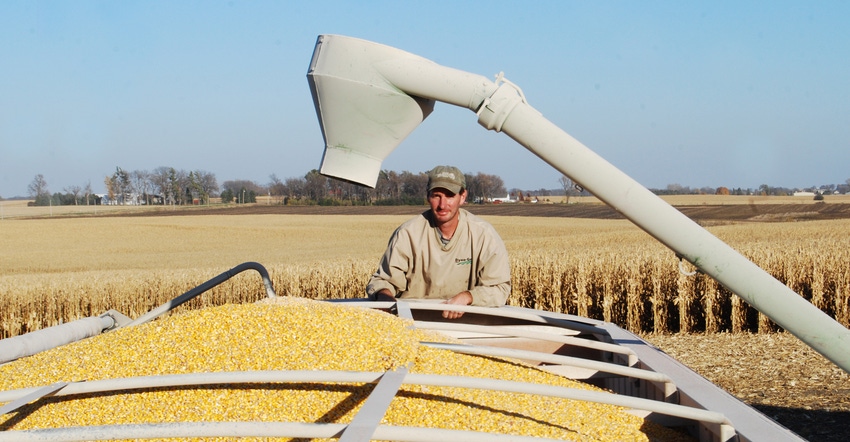December 4, 2019

Farmers have until March 15 to sign up for the new versions of the Agricultural Risk Coverage and Price Loss Coverage programs offered by USDA for 2019 and 2020 commodity crops. Now is the time for producers to gather the needed information to make their decisions. Don’t wait until the deadline to head to your local Farm Service Agency to elect and enroll. FSA offices will be busy this winter.
That’s the main takeaway from about 80 meetings that started in November and will run through January across Iowa, where farmers and landowners can learn about the program options. The meetings are sponsored by Iowa State University Extension and FSA.
Under the 2018 Farm Bill, producers can sign up by commodity crop and by FSA farm number in ARC-County (ARC-CO) or PLC. Or they can sign up their entire farm in ARC-Individual Coverage (ARC-IC). Those program elections will apply for the 2019 and 2020 crop years. Beginning in 2021, producers can change their program election and enroll annually. This is a five-year farm bill, running through the 2023 crop year.
Chance to update PLC
Farmland owners also have an opportunity to update the program payment yields for PLC beginning with the 2020 crop. “As producers may decide to elect and enroll in a different program in later years of the farm bill, updating the yields now may prove beneficial,” says Steve Johnson, ISU Extension farm management specialist. “The choice to update yields is one that both landowners and tenant operators should consider.”
ISU Extension economist Alejandro Plastina has prepared a decision tool to help with the yield update decision. The only information needed is the actual farm yields for 2013 through 2017 on a planted acre basis and the existing PLC yield. This decision tool is available on the ISU Ag Decision Maker website at 2018 Farm Bill: PLC Payment Yield Update, A1-35.
After identifying your farm in the top part of the worksheet by FSA farm number, enter the current PLC yield for corn and soybeans. Then choose the county where the farm is located, and the substitute yields for corn and soybeans will show for the county chosen. Actual farm yields can be entered for years 2013-17.
If a commodity was not planted in a given year, leave the entry cell blank or enter “not planted.” However, if yield records aren’t available for a given year the crop was planted or a low yield is entered, the substitute county yield will appear.
The worksheet calculates the higher of the substitute yield or the actual farm yield for each year, then applies the crop ratio (90% for Iowa crops) and gives the new program yield.
This updated PLC yield for each commodity will only update if the new calculation results in a higher yield. Form CCC-867 must be signed by the landowner with the FSA office to complete the process, or have a power-of-attorney form on file with FSA.
ARC, PLC payment estimator
A second tool is ISU’s ARC and PLC payment estimator at Farm Bill Programs: Data and Methods for ARC-County and PLC, A1-33. Johnson believes PLC will probably be the preference for corn base acres and ARC-CO for soybean base acres by most Iowa farmers for 2019 and 2020 crop years. He expects two exceptions: First, in counties with an extremely low 2019 corn yield, or possibly in 2020, farmers might stay with ARC-CO. Secondly, farms with all prevented planting acres in 2019 will likely elect and enroll in ARC-IC. Producers will need to plug expected county yields and national cash prices into the estimator and run the calculations.
Decide on program in 7 steps
Johnson suggests these seven steps to decide between ARC or PLC. Begin collecting important data to help make your final election and enrollment decision:
Find your farms’ base acres and PLC yield (request FSA Form 156-EZ).
Estimate your county yields for both 2019 and 2020 crops.
Project the national cash price averages for the 2019-20 and 2020-21 marketing years.
Place this information into the ARC-PLC payment estimator for your county.
Compare by crop and FSA farm number the potential ARC vs. PLC payments for both 2019 and 2020.
Elect and enroll in ARC and/or PLC by crop and FSA farm number.
Consider updating to a new PLC yield using 2013 through 2017 crop production evidence for that farm.
“The biggest challenge will likely be Steps 2 and 3,” Johnson says. For 2019 he suggests using the projected prices in USDA’s World Agricultural Supply and Demand Estimates Report released monthly. The 2020 crop price projections will likely come from the Food and Agricultural Policy Research Institute baseline update. These prices will be included in the ARC-PLC payment calculators and are being discussed at the farm bill meetings.
About the Author(s)
You May Also Like






